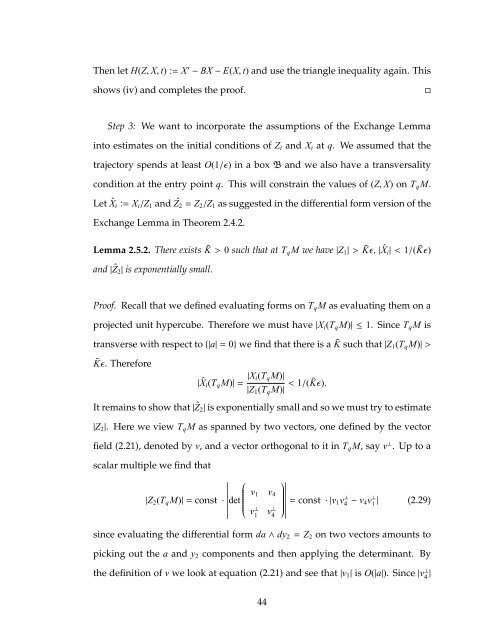multiple time scale dynamics with two fast variables and one slow ...
multiple time scale dynamics with two fast variables and one slow ...
multiple time scale dynamics with two fast variables and one slow ...
You also want an ePaper? Increase the reach of your titles
YUMPU automatically turns print PDFs into web optimized ePapers that Google loves.
Then let H(Z, X, t) := X ′ − BX−E(X, t) <strong>and</strong> use the triangle inequality again. This<br />
shows (iv) <strong>and</strong> completes the proof. <br />
Step 3: We want to incorporate the assumptions of the Exchange Lemma<br />
into estimates on the initial conditions of Zi <strong>and</strong> Xi at q. We assumed that the<br />
trajectory spends at least O(1/ǫ) in a box B <strong>and</strong> we also have a transversality<br />
condition at the entry point q. This will constrain the values of (Z, X) on TqM.<br />
Let ˆXi := Xi/Z1 <strong>and</strong> ˆ<br />
Z2= Z2/Z1 as suggested in the differential form version of the<br />
Exchange Lemma in Theorem 2.4.2.<br />
Lemma 2.5.2. There exists ¯K> 0 such that at TqM we have|Z1|> ¯Kǫ,| ˆXi|<br />
¯Kǫ. Therefore<br />
| ˆXi(TqM)|= |Xi(TqM)|<br />
|Z1(TqM)| < 1/( ¯Kǫ).<br />
It remains to show that|ˆZ2| is exp<strong>one</strong>ntially small <strong>and</strong> so we must try to estimate<br />
|Z2|. Here we view TqM as spanned by <strong>two</strong> vectors, <strong>one</strong> defined by the vector<br />
field (2.21), denoted by v, <strong>and</strong> a vector orthogonal to it in TqM, say v ⊥ . Up to a<br />
scalar <strong>multiple</strong> we find that<br />
<br />
⎛<br />
<br />
<br />
|Z2(TqM)|=const·<br />
<br />
<br />
det<br />
⎜⎝<br />
<br />
v1 v4<br />
v ⊥<br />
1<br />
v ⊥<br />
4<br />
⎞<br />
<br />
<br />
<br />
<br />
<br />
⎟⎠<br />
<br />
<br />
= const·|v1v ⊥<br />
4<br />
⊥<br />
− v4v1 | (2.29)<br />
since evaluating the differential form da∧dy2= Z2 on <strong>two</strong> vectors amounts to<br />
picking out the a <strong>and</strong> y2 comp<strong>one</strong>nts <strong>and</strong> then applying the determinant. By<br />
the definition of v we look at equation (2.21) <strong>and</strong> see that|v1| is O(|a|). Since|v ⊥<br />
4 |<br />
44
















